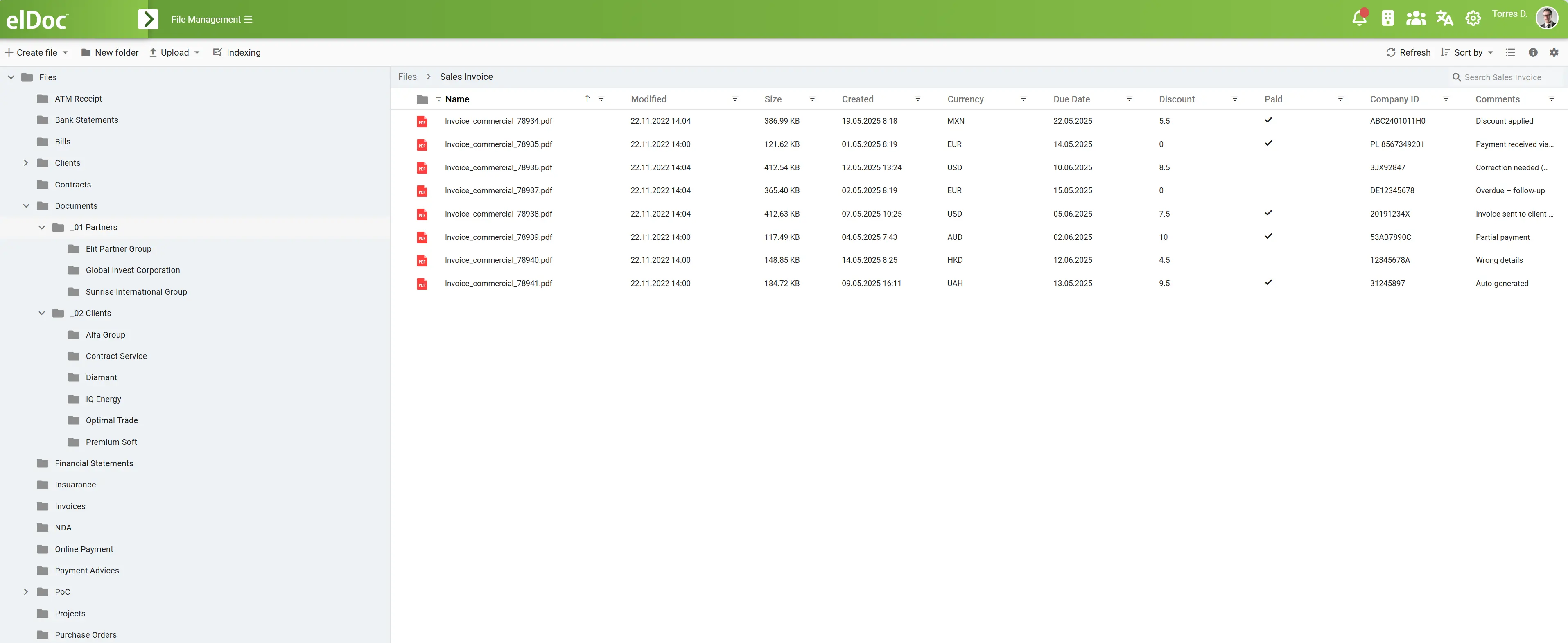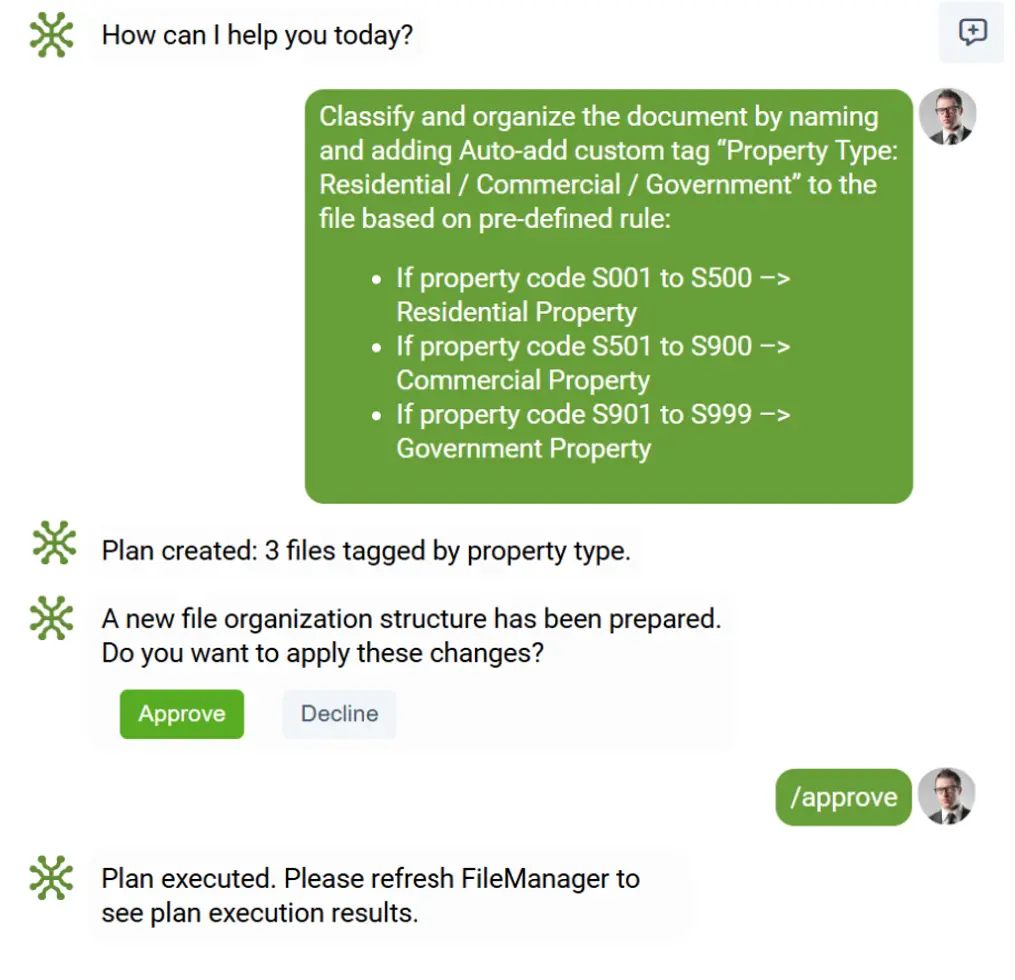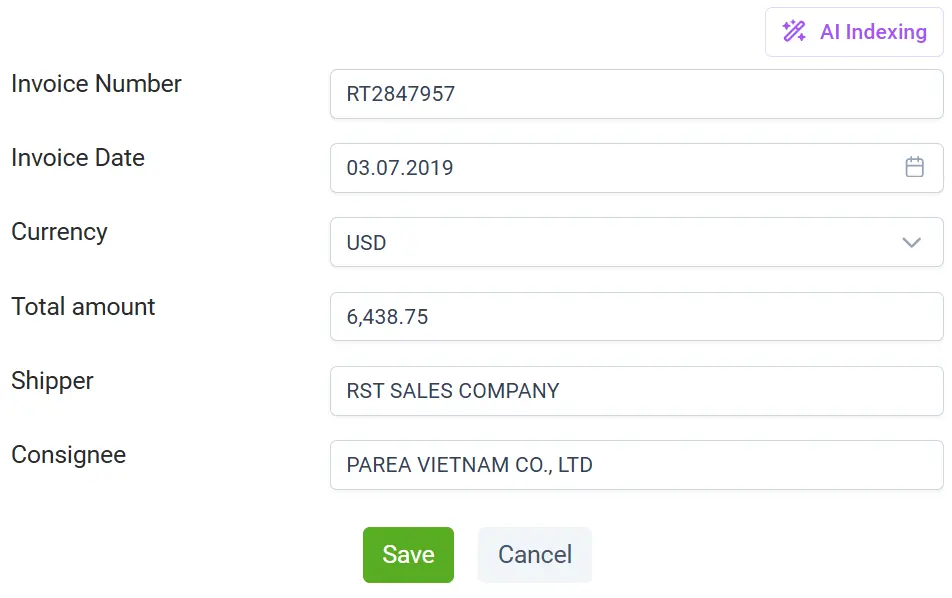Organizing Files with AI: The End of Manual Sorting in Business Operations

In every organization, there’s one task that has stubbornly resisted digital transformation – document sorting and organization.
Every day, companies receive an endless stream of files – contracts, invoices, forms, statements, reports, scanned letters arriving through email, portals, or physical scanners. And before any of these can be processed or analyzed, someone has to open, read, and decide what each document is and where it belongs.
For many businesses, especially in document-heavy sectors such as banking, insurance, auditing, or real estate, this simple-sounding task consumes enormous resources. Entire teams sometimes five or more full-time employees spend their working hours doing nothing but sorting, renaming, and filing thousands of documents into folders or systems. It’s repetitive, time-consuming, and prone to human error – yet historically, it has been unavoidable.
We’ve all imagined a world where this could be automated where systems could instantly understand what each document represents and organize it accordingly. But until recently, that level of automation was impossible.
Legacy systems could scan text and extract data, but they lacked true understanding. They couldn’t grasp the meaning, context, or intent behind a document. A human still had to interpret whether a file was a client contract, a supplier invoice, or a regulatory form and decide what to do with it.
That’s no longer the case.
Thanks to Artificial Intelligence and LLM, and specifically to elDoc’s AI Document Employee, intelligent document organization has become a practical, reliable reality.
Now, your digital workforce can read, comprehend, and classify documents the way a trained employee would only faster, more consistently, and at any scale. Whether files come from scanners, emails, or bulk uploads, elDoc’s AI Document Employee processes them instantly, applying computer vision and natural language understanding to make intelligent filing decisions in seconds.
What was once a tedious manual task has evolved into an AI-driven workflow transforming document chaos into structured, searchable, and compliant order.
Key Challenges in Traditional File Organization: The End of the Era of Manual Sorting
For decades, organizations have relied on people to do what machines simply couldn’t read, understand, and correctly sort documents.
It’s one of those invisible yet essential tasks that keeps business operations moving but as document volumes have exploded, it’s become a major operational burden.
Before AI with LLM, even the most advanced systems could only extract text or basic metadata. The real work —the thinking and decision-making still required human judgment.
As a result, companies faced persistent challenges that slowed productivity and limited scalability.
👩💼 Manual Effort and Cognitive Fatigue
Teams spent hours opening files, reading through content, and deciding where each document belonged.
This repetitive, high-volume work caused mental fatigue, reduced accuracy, and frequent burnout — especially among employees responsible for large-scale document processing.
⚠️ Human Errors and Compliance Risks
Even small missteps — a wrongly labeled file, an incomplete record, or a misplaced document — can trigger operational or compliance issues.
In highly regulated sectors such as banking, insurance, and healthcare, these mistakes can lead to audit complications or costly penalties.
📈 Scalability Challenges
As organizations expanded, document inflows multiplied.
The only way to keep up was to add more staff, increasing costs without improving efficiency. Manual sorting simply doesn’t scale in the era of digital transformation.
🗂️ Inconsistent Naming Conventions
When multiple people manage files, each applies their own naming logic.
One might save a file as Invoice_ClientA_2023, another as 2023_ClientA_INV.
The outcome is fragmented repositories, low traceability, and hours wasted searching for the right document.
🔍 Lack of Contextual Understanding
Legacy systems relied on keywords, not comprehension.
They could detect the word “contract” but couldn’t distinguish between a lease, employment, or vendor agreement.
That gap in understanding meant human review was always needed — until now.
⏳ The Consequences of Staying Manual
These inefficiencies ripple across entire organizations:
Finance teams delay reports while chasing missing invoices.
Compliance teams struggle during audits.
Customer support slows down because essential records are hard to locate.
The result is clear – manual document organization has reached its limit.
But with the emergence of AI-driven document intelligence, this era is finally coming to a close.
AI can now do what humans once did – understand, categorize, and organize files intelligently, marking the true end of manual document sorting.
How elDoc’s AI Document Employee Solves It
With elDoc’s AI Document Employee, the entire process of document sorting and organization becomes intelligent, seamless, and fully automated.
What once took teams hours or days can now be completed in minutes — with higher accuracy, consistency, and zero fatigue.
Here’s how it works in practice:
1. Upload Your Files — Any Format
No matter where your documents come from scanner, shared drive, email inbox, or bulk upload — elDoc’s AI Document Employee can handle them all.
It supports:
- Scanned PDFs and image files
- Text-based digital documents
Simply drop them into elDoc, and the AI takes care of the rest preparing your files for intelligent processing instantly.
2. AI-Powered OCR and Computer Vision
As soon as documents are uploaded, elDoc automatically applies advanced OCR (Optical Character Recognition) and computer vision technology to make every page clear, readable, and ready for understanding.
Here’s what happens behind the scenes:
- Automatic rotation and alignment: Skewed or upside-down scans are instantly corrected.
- Image enhancement: Low-quality scans are cleaned for sharper text extraction.
- Printed and handwritten recognition: Both typed and handwritten information is captured accurately.
In short, even the most complex scanned files become searchable and structured digital assets.
3. Intelligent Classification
This is where AI truly shines. Once files are processed, elDoc’s AI Document Employee reads and comprehends their content — not just keywords, but actual context.
You can simply type a natural command such as:
“Classify documents by type and year.”
“Organize invoices by vendor and month.”
“Group property documents by region and code.”
The AI instantly understands your intent and sorts files accordingly assigning metadata, tagging documents, and placing them in the right folders or categories.
It’s automation that thinks like a human, but works at machine speed.
4. Smart File Renaming and Structuring

Once classified, you can take organization to the next level with AI-based file renaming.
Just give a simple instruction:
“Rename all files as per your pattern or business logic.”
The AI automatically generates consistent, meaningful filenames following your pattern or business logic.
No manual typing. No inconsistencies. Just perfectly structured and traceable files across your repository.
This not only improves internal collaboration but also enhances searchability and compliance traceability – critical for regulated industries.

5. Classification and Renaming — Just the Tip of the Iceberg
The ability to classify and rename files is only the beginning of what AI can do inside elDoc.
With the AI Document Employee, you can go far beyond sorting and naming unlocking the full potential of AI-driven document intelligence.
Here’s what lies beneath the surface:
- AI Indexing: elDoc can intelligently index your entire document library — by date, department, client, or any other attribute you choose — without manual setup or predefined templates.
- AI Data Capture: The AI extracts key data fields directly from documents, instantly recognizing names, dates, invoice numbers, amounts, or codes — with no need for templates, custom rules, or human configuration.
- AI Deep Document Analysis: elDoc can analyze thousands of documents per second, performing comprehensive reviews, pattern recognition, and even context-based compliance checks. It doesn’t just process information — it understands it.
- AI-Assisted Review and Validation: Whether you’re conducting audits, contract reviews, or compliance validations, the AI Document Assistant acts as your tireless digital co-worker — ensuring accuracy, consistency, and speed.
With elDoc, the possibilities are virtually unlimited.
What once required large teams, multiple systems, and days of effort can now be executed instantly with AI precision and human-like understanding.
What was impossible before is now effortless with elDoc’s AI Document Assistant redefining how organizations manage, analyze, and trust their documents.

File Organization Reinvented with AI
The era of manual document sorting is coming to an end.
What used to take entire teams days or weeks to complete can now be done in minutes accurately, consistently, and intelligently. With elDoc’s AI Document Employee, organizations can finally bridge the gap between human-level understanding and digital efficiency. The platform doesn’t just read text it comprehends meaning, context, and intent. It doesn’t just store data — it creates structure, insight, and actionable intelligence.
elDoc transforms your files into a living, intelligent repository where every document is instantly classified, indexed, and retrievable — regardless of volume or complexity. It’s not just about automation; it’s about redefining how companies interact with information.
For banks, that means faster loan processing, real-time compliance checks, and effortless retrieval of client records.
For audit and accounting firms, it means automated sorting of invoices, financial statements, and expense reports — enabling teams to focus on high-value analysis rather than routine filing.
For real estate and legal organizations, it means instant categorization of agreements, property records, and government documents, all accurately tagged and accessible.
And for any document-intensive enterprise, it means a complete transformation in productivity, accuracy, and control.
AI-powered file organization is no longer just a convenience — it’s a strategic advantage.
It empowers businesses to operate faster, make decisions with confidence, and ensure compliance with ease — all while reducing costs and manual workload.
The result is a new kind of efficiency: smart, autonomous, and adaptive.
With elDoc, every document tells its story — clearly, accurately, and instantly.
Welcome to elDoc — where AI turns document chaos into clarity.
Let's get in touch
Explore elDoc AI Document Intelligence up close - our team will be happy to assist you
Get your questions answered or schedule a demo to see our solution in action — just drop us a message
